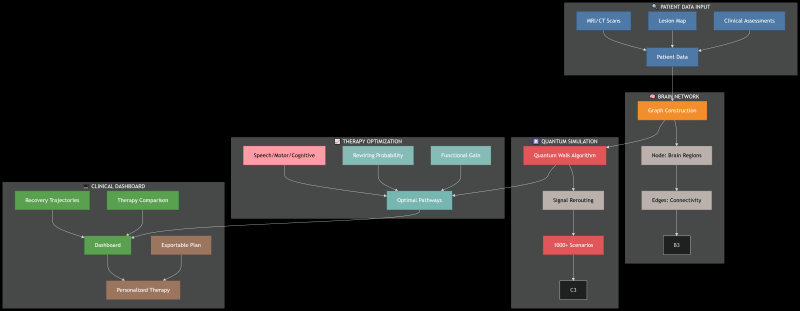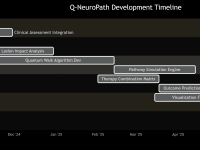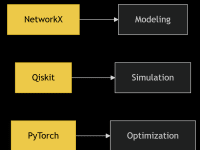Q-NeuroPath: A Quantum-Inspired and Generative AI-Enhanced Simulation Platform for Personalized Neuro-Recovery
Q-NeuroPath is a software platform I plan to develop to support personalized recovery after stroke and brain injury. The idea came from noticing how rehabilitation today often depends on trial-and-error, where therapists follow standard routines and adjust over time. But every brain is different, and I believe we can do better by simulating how a specific brain might respond to different therapies before applying them in real life. Q-NeuroPath is meant to do exactly that.
The core concept is to model the brain as a dynamic network. When a stroke disrupts certain connections, the brain tries to reroute functions through alternate pathways — a process called neuroplasticity. Using quantum-inspired algorithms like quantum walks and annealing, the platform would simulate these alternate routes and evaluate which therapy combinations are most likely to activate them. This way, clinicians could see several possible recovery paths and make data-driven decisions instead of guessing what might work best.
To make this system more intelligent and accessible, I also plan to integrate generative AI. It would help generate realistic, synthetic patient datasets for testing the simulator safely without relying on private medical records. GenAI would also let therapists describe a patient’s condition and recovery goals in everyday language, which the system would then convert into structured inputs for simulation. Finally, it would generate clear, human-readable summaries of the simulation results — helping professionals and even patients understand what each possible path looks like.
From everything I’ve researched — across Google Scholar, PubMed, IEEE Xplore, and GitHub — there’s no tool currently available that combines quantum-inspired simulation and generative AI for rehabilitation planning. There are AI models that predict outcomes or classify stroke lesions, but none that simulate how the brain might recover under different therapy strategies. That’s where I believe Q-NeuroPath can offer something genuinely new.
This idea is fully software-based and feasible to build with existing tools. Python libraries like NetworkX can represent the brain’s network. Quantum-inspired algorithms can be simulated using Qiskit or D-Wave’s Ocean SDK. Language models and prompt-based interfaces can be built with open-source GenAI frameworks. The system would be designed to run on standard hospital infrastructure or even securely in the cloud, without the need for specialized hardware. I also see potential for future integration with EEG or fMRI data to make the simulations even more accurate.
The potential use cases are wide. Q-NeuroPath could support neurologists, physical therapists, and rehabilitation centers in creating more effective therapy plans. It could also be valuable in research labs exploring new models of neuroplasticity. For patients, especially in settings where expert resources are limited, it could mean a faster and more targeted recovery path.
To me, Q-NeuroPath represents a step toward making recovery more intelligent, personal, and efficient. Ultimately, I believe recovery shouldn’t be a guessing game. With Q-NeuroPath, I hope to give clinicians a clearer view of what’s possible and help patients get the best shot at regaining their lives.
Like this entry?
-
About the Entrant
- Name:Deepthi Sree Dubasi
- Type of entry:individual
- Software used for this entry:Python (NetworkX, NumPy), Qiskit, D-Wave Ocean SDK, OpenAI GPT APIs
- Patent status:none









